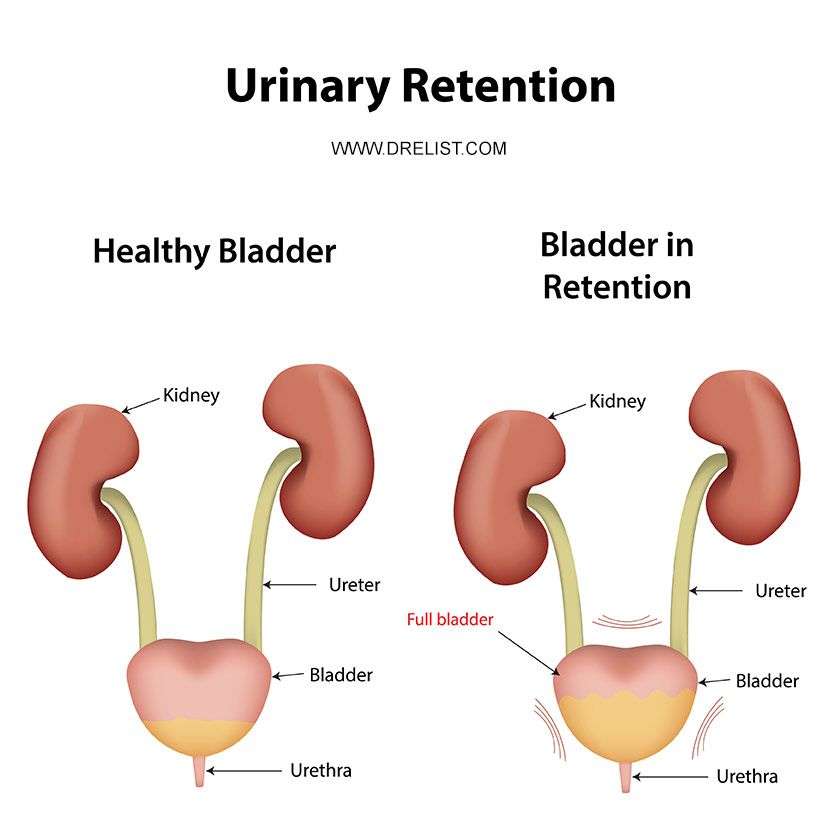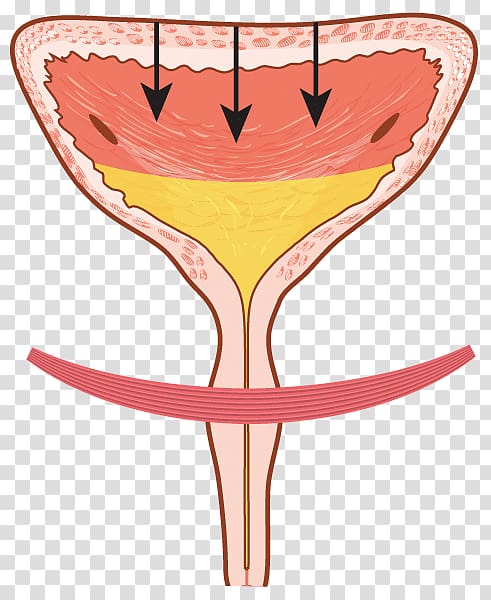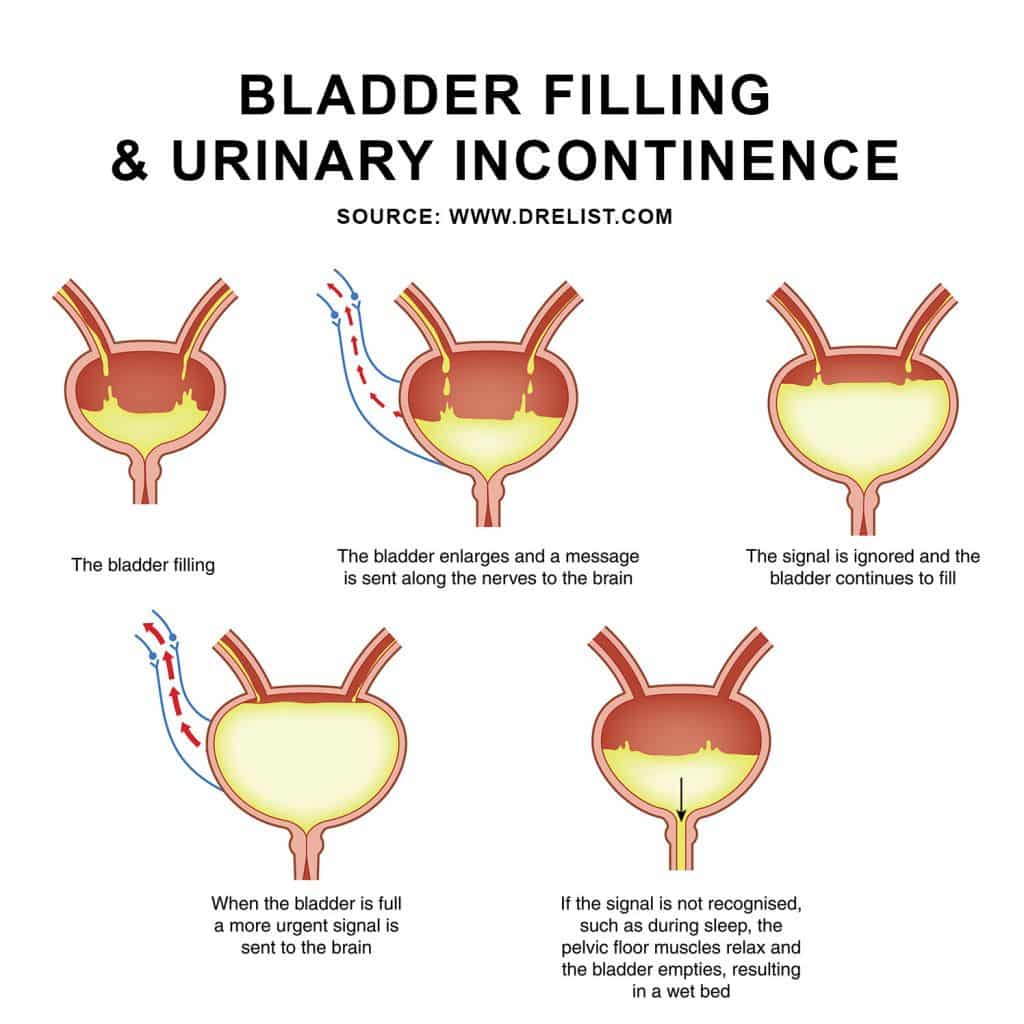Causes And Risk Factors
Aging
OAB occurs in both men and women. Its possible to have overactive bladder at any point in your life. But, its especially common in older adults. The prevalence of OAB in people younger than 50 years of age is less than 10 percent. After the age of 60, the prevalence increases to 20 to 30 percent.
The following are some of the other most common underlying causes and risk factors associated with OAB symptoms:
Nerve Damage
A healthy, normal functioning bladder holds urine until it gets full and is prompted to empty by nerve signals. However, when nerve damage occurs in the body, the muscles surrounding the urethra can be too loose. This undesirable looseness can cause someone to become incontinent. What can cause nerve damage that can then lead to bladder leakage? Some possibilities include:
- Back or pelvis surgery
Weak pelvic muscles
When a man or womans pelvic floor muscles are weak, bladder control issues can happen. The pelvic floor muscles are like a sling that holds up the uterus and bladder. For women, a pregnancy and childbirth can often lead to a stretching and weakening of the vital pelvic floor muscles. When pelvic floor muscles are compromised for this reason or another, the bladder can then sag out of place. The opening of the urethra also stretches and urine easily leaks out.
Menopause
Extra weight or obesity
Diuretic medications
Interstim Therapy At A Glance
- InterStim Therapy, which treats overactive bladder, urinary incontinence, urinary retention and fecal incontinence, involves sending electrical pulses to the sacral nerves, located in the lower area of the spinal cord.
- The sacral nerves affect bladder and bowel function.
- Of the more than 225,000 patients treated by InterStim for bladder and bowel control therapy, 85 percent achieved success in the first year.
- Before the InterStim device that generates the electrical pulses is surgically implanted, the patient will have a trial period to assure the therapy will reduce condition symptoms.
What Medications Are Used To Treat Overactive Bladder
As youre retraining your bladder, a healthcare provider may prescribe medication. Medications can help restore normal bladder function. Commonly prescribed medications for overactive bladder include:
Anticholinergic medications
Beta-3 adrenergic medication
Beta-3 adrenergic medications cause the detrusor muscles in your bladder to relax so your bladder can store more pee. A healthcare provider may prescribe:
Don’t Miss: Why Does My Bladder Leak
All About Urinary Tract Infections
This site is dedicated to providing you with the best information regarding urinary tract infections , an infection that can occur in any part of the urinary system kidneys, ureters, bladder, and urethra. We aim to provide the most comprehensive resource available about UTIs and how to properly address them.
We provide you with impartial, up-to-the-minute information regarding this very common infection, which affects many individuals. UTIs are quite common, so understanding causes, symptoms and which measures can be taken to help eradicate this uncomfortable condition, once and for all.
How Does A Doctor Diagnose Overactive Bladder

To get a diagnosis of overactive bladder, your doctor starts with a complete health history to learn about other urinary conditions youâve had in the past, and when the problem started. Your doctor will examine you, ask questions, and perform tests.
Questions your doctor may ask about your OAB include:
- How often do you urinate?
- How often do you leak urine, and how severely?
- Do you feel any pain or discomfort while urinating?
- For how long has the urge or urinary incontinence been occurring?
- Do you use incontinence pads, and if so, how many per day?
- What medications are you taking?
- Have you had any recent surgery or illnesses?
Keeping an OAB diary at home can help you answer these questions and help with an overactive bladder diagnosis. Each day, write down how much you drink, when you urinate, how much you urinate each time, and whether you ever feel an urgent need to go.
Your doctor will then examine your abdomen, pelvis, genitals, and rectum. You might also have a neurological exam to look for problems in your nervous system that could affect your ability to urinate. Constipation can also lead to urinary incontinence and urinary retention.
You May Like: Causes Of Frequent Bladder Infections
Limited Fluid Intake Due To Renal Disease
Some patients have kidney damage that forces them to limit their fluid intake to prevent fluid overload. If you have this problem, you should avoid nonprescription products that must be taken with a lot of fluid so you can get them down. This includes bowel regulation products containing psyllium and methylcellulose.
You May Like: Over The Counter Urinary Incontinence
When Should I See A Health Care Professional
See a health care professional right away if you are unable to urinate or have severe pain in your abdomen. Acute urinary retention can be life threatening.
If you have any of the other symptoms of urinary retention, such as trouble urinating, frequent urination, or leaking urine, talk with your health care professional about your symptoms and possible treatments. Chronic urinary retention can cause serious health problems.
Dont Miss: Urinary Tract Infection Go Away On Its Own
You May Like: Bladder Infection Everytime After Intercourse
Sacral Neuromodulation For Bladder Control
InterStim Therapy for Urinary Control treats urinary retention and the symptoms of overactive bladder, including urinary urge incontinence and significant symptoms of urgency-frequency. It should be used after you have tried other treatments such as medications and behavioural therapy and they have not worked, or you could not tolerate them.
You should have a successful trial assessment before receiving InterStim Therapy. If you dont have an appropriate response to test stimulation or are unable to operate the neurostimulator then Interstim Therapy may not be the best treatment option for you. You cannot have diathermy if you have an InterStim device and this should be discussed with your health care professional
InterStim Therapy is not intended for patients with a urinary blockage. Safety and effectiveness have not been established for pregnancy and delivery patients under the age of 16 or for patients with neurological diseases such as multiple sclerosis. Your health care professional should discuss if Interstim therapy is an appropriate choice for you.
In addition to risks related to surgery, complications can include pain at the implant sites, new pain, infection, lead movement/migration, device problems, interactions with certain other devices or diagnostic equipment such as MRI, undesirable changes in urinary or bowel function, and uncomfortable stimulation .
What Tests Will Be Done To Diagnose Overactive Bladder
A healthcare provider may order tests to help diagnose overactive bladder. These tests may include:
- Urinalysis. A urinalysis examines the visual, chemical and microscopic aspects of your pee. A provider will look for red blood cells, white blood cells and bacteria. If you have any of them in your pee sample, you may have an infection that causes OAB.
- Urodynamic testing. Urodynamic tests measure how much pee remains in your bladder after you go to the bathroom, how much you pee, how fast you pee and how much pressure is on your bladder as it fills with pee.
- Ultrasound. An ultrasound is a noninvasive imaging test that allows a healthcare provider to take a detailed look at your bladder.
- Computed tomography scan. A CT scan is a noninvasive imaging test that produces 3D images of your bladder.
- Cystoscopy. A healthcare provider will use a special instrument to look inside your bladder from your urethra. The provider typically uses a numbing gel so you dont feel pain in your urethra. In rare cases, they may use general anesthesia, so you arent awake, wont move and wont feel any pain.
Also Check: How Do Doctors Test For Bladder Infection
Some Medications For Type 2 Diabetes
The newer medications for type 2 diabetes, a class called sodium-glucose cotransporter-2 inhibitors work by increasing the amount of glucose or blood sugar your kidneys excrete and pass through urine, which takes fluid with it, says Varin. Some good news: There was a concern that SGLT2 inhibitors would also increase the risk of urinary tract infection , but newer research has failed to find that connection, suggests the February 2020 issue of Clinical Kidney Journal.
What Questions Should I Ask A Healthcare Provider
- How do you know that I have an overactive bladder?
- Whats the cause of my overactive bladder?
- Whats a normal number of times to pee each day?
- How much should I drink each day?
- What fluids should I drink?
- What fluids should I avoid drinking?
- What foods should I eat?
- What foods should I avoid eating?
- What treatments do you recommend?
- Are there any side effects to your recommended treatment?
- What medications do you recommend?
- Are there any side effects to your recommended medications?
- Are there any other lifestyle changes I can make?
- Can you recommend a support group for people with overactive bladder?
A note from Cleveland Clinic
Overactive bladder is a common condition that causes changes in your bathroom habits, which can be embarrassing. Many people struggle to talk to a healthcare provider about their symptoms. However, providers can help answer any of your questions without judgment. They can determine the cause of your overactive bladder and work with you to develop the best treatment plan. If you have symptoms of overactive bladder, talk to a healthcare provider so you can regain control of your bathroom habits and improve your quality of life.
You May Like: What Is Bowel And Bladder Incontinence
Symptoms Of Underactive Bladder
People with underactive bladder may experience difficulty passing urine or even inability to pass urine. Others may experience
- very light streams of urine
- interrupted urine stream
- abdominal pain and swelling
Its important to treat underactive bladder promptly as this condition may lead to kidney failure if left untreated.
Effectiveness Of Interstim Devices For Bowel Incontinence

In study results published in the medical journal Annals of Surgery, 120 patients and their doctors tracked the effectiveness of the therapy.
- About half of the patients experienced total recovery of bowel control and reported no incontinence problems for one year after the surgery
- 30% reported that their bowel leaks were reduced by more than 50%
- InterStim therapy produced significant positive results for more than 8 out of 10 patients
Read Also: How Do You Diagnose Overactive Bladder
Also Check: Side Effects Of Radiation For Bladder Cancer
What To Expect After The Device Is Implanted
Most patients will notice a slight pulling or tingling sensation, according to Medtronic, which manufactures the InterStim devices. These sensations should not be painful if they are, contact your doctor. Sudden movement can also cause a change in how the stimulation feels, because the device shifted in proximity to your sacral nerve. This doesnt affect the effectiveness of the stimulation has changed. After a few weeks, patients typically report they dont notice the sensation anymore.
The goal is for InterStim therapy to help patients return to their daily routines without worrying about bowel or urinary incontinence. A successful procedure should help patients be more confident of their ability to go through life, taking long walks, traveling or visiting a movie theater. Things that were difficult become possible, once patients are no longer worried about incontinence.
Inserting The Interstim Therapy Device
Since nerve stimulation is not an answer for everyone, there is a test trial period before the InterStim device is implanted. Doctors perform the test phase procedure in an operating room or a medical office. The doctor will numb a small area and insert a thin, flexible needle near the tailbone. This needle will be attached to a wire placed near the sacral nerves.
Once the doctor has located the optimal location, the temporary testing wire will be secured and attached to an external battery, which can be placed on the patients belt. The patient will have a remote to adjust the level of stimulation. This allows each patient to tailor the device to meet his or her needs.
The testing period will take between 1-3 weeks. During this time the doctor will ask the patient to complete a bladder diary to track daily urinary habits.
If there is improvement in the urinary or fecal symptoms, the second stage of the procedure will be performed to implant the permanent battery in the upper part of the buttock. The battery is similar to a heart pacemaker.
With both procedures, the patient will be able to go home the same day, but will need a driver.
Recommended Reading: Reasons For Lack Of Bladder Control
Read Also: Urge To Urinate When Bladder Is Empty
A Common Aging Problem
The male urinary tract is prone to problems that worsen with age.
Lower urinary tract symptoms are a broad spectrum of clinical manifestations related to the bladder,urethra, and prostate gland. LUTS affect as many as 70% of men over 80 years of age.5
Besides nocturia, these symptoms can include increased urinary frequency, urgency, incontinence, incomplete bladder emptying, hesitancy, prolonged micturition, dribbling and a weak urine stream.6
The worsening of LUTS as men get older is due to various factors that cause dysfunction of the urinary system.7 An overactive bladder, enlargement of the prostate gland, and damage to the urethra can all contribute to urinary symptoms.
Compounds that incite chronic inflammation in the urinarytract can contribute to the development of LUTS and prostate enlargement.8,9 Men with LUTS have increased levels of plasma pro-inflammatory biomarkers.8
The aging process increases the risk for all of these problems. Obesity, diabetes, high blood pressure, smoking, some medications, nervous system disorders, and others can also contribute to LUTS.10
Recommended Reading: What Can I Take To Cure A Urinary Tract Infection
Who Is A Candidate For Treatment With Sacral Neuromodulation
InterStim® therapy is approved for usage by Medicare in Australia in people older than 18 years of age whose symptoms have not responded to medical and conservative treatments over at least 12 months due to:
- Overactive bladder due to detrusor overactivity or
- Paradoxically also in patients with urinary retention which is not due to a blockage in the urinary tract
In Australia InterStim® therapy is also approved for use in some patients with refractory faecal incontinence which has not responded to other treatments.
Don’t Miss: Will Amoxicillin Cure A Bladder Infection
When To See A Doctor
Overactive bladder isnt only annoying, but it can be stressful and take a serious toll on your quality of life. For some people, symptoms can be so severe that they begin to withdraw from activities they enjoy because theyre afraid of being too far from a bathroom. With that in mind, you should see your doctor right away if youre showing signs.
The Cleveland Clinic also points out that symptoms wont go away on their own, so its important to receive a proper diagnosis from a health professional. From there, your medical team will be able to determine the best treatment plan for you.
Melatonin And Acute And Chronic Detrusor Overactivity Models
In acute detrusor overactivity, melatonin does not significantly affect any of the urodynamic parameters. In urodynamic studies recorded in chronic detrusor overactivity, however, it is associated with an increase in inter-contraction interval, increased bladder capacity, and an increase in threshold pressure . These effects are due to melatonins antioxidative function and not through its receptors because administering agomelatine, an antidepressant with melatonergic activity, deteriorates bladder dysfunction. However, this may not be the only reason behind agomelatines action on the bladder. It may induce bladder overactivity by its 5HT2C receptor antagonism. Also, peripheral melatonin administration results in more antioxidative effects without involving the receptor .
Recommended Reading: Side Effects Of Bladder Cancer
Bladder Has Two Distinct Roles
What Is Interstim Sacral Nerve Stimulation Therapy And How Does It Prevent Urinary Incontinence

InterStim® is a sacral nerve stimulation therapy that allows you to regain bladder and bowel control. When an overactive bladder is causing incontinence, InterStim®, which is a small device placed near the pelvis, engages with the sacral nerves, stimulating them through pulses.
The sacral nerves control your bladder and bowel, and allow certain pelvic functions. A neurostimulator and lead in the device work together to stimulate the sacral nerve electrically, restoring proper neural activity, meaning that your brain and bladder will be in sync, enabling your urinary system to function properly.
The InterStim® system is:
- Conducted with a small device.
- Designed to send electrical impulses to the sacral nerves.
- Capable of lessening or stopping incontinence and other bladder-related issues.
The InterStim® device is inserted in the body through a minimally-invasive procedure conducted under anesthesia.
Recommended Reading: Lemon Water Good For Bladder Infection
Why Is This Happening
There are two general types of urinary retention: obstructive and non-obstructive. If there is an obstruction , urine cannot flow freely through the urinary tract. Non-obstructive causes include a weak bladder muscle and nerve problems that interfere with signals between the brain and the bladder. If the nerves arent working properly, the brain may not get the message that the bladder is full.
Some of the most common causes of non-obstructive urinary retention are:
- Impaired muscle or nerve function due to medication or anesthesia
- Accidents that injure the brain or spinal cord
Obstructive retention may result from:
- Enlarged prostate in men
Please note: InterStim is not indicated for Obstructive Retention